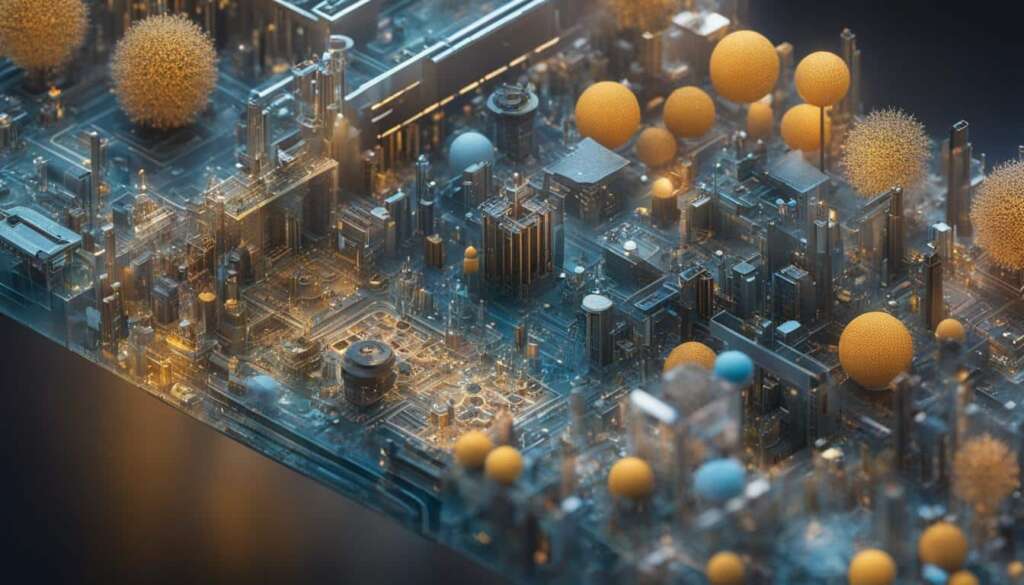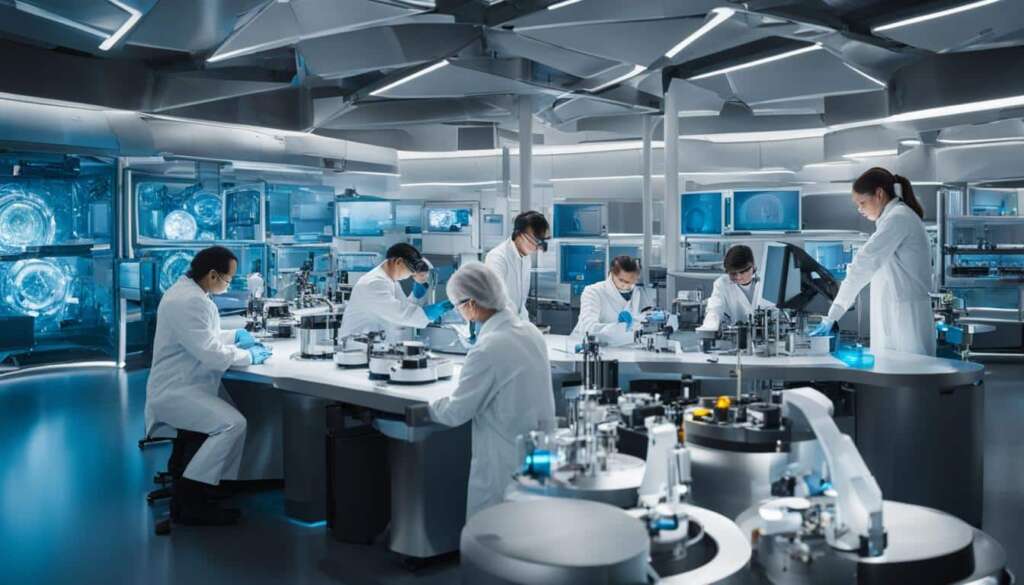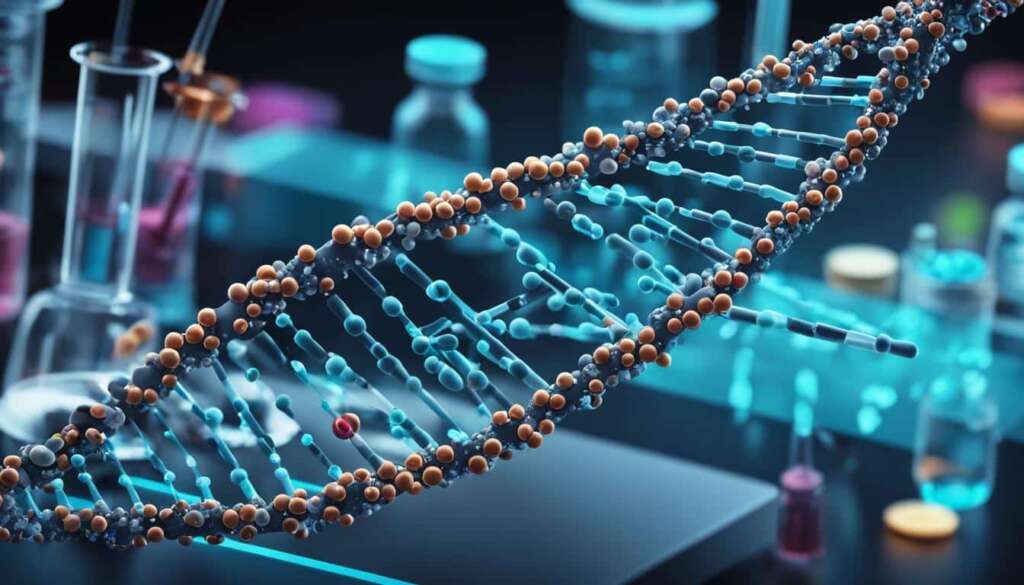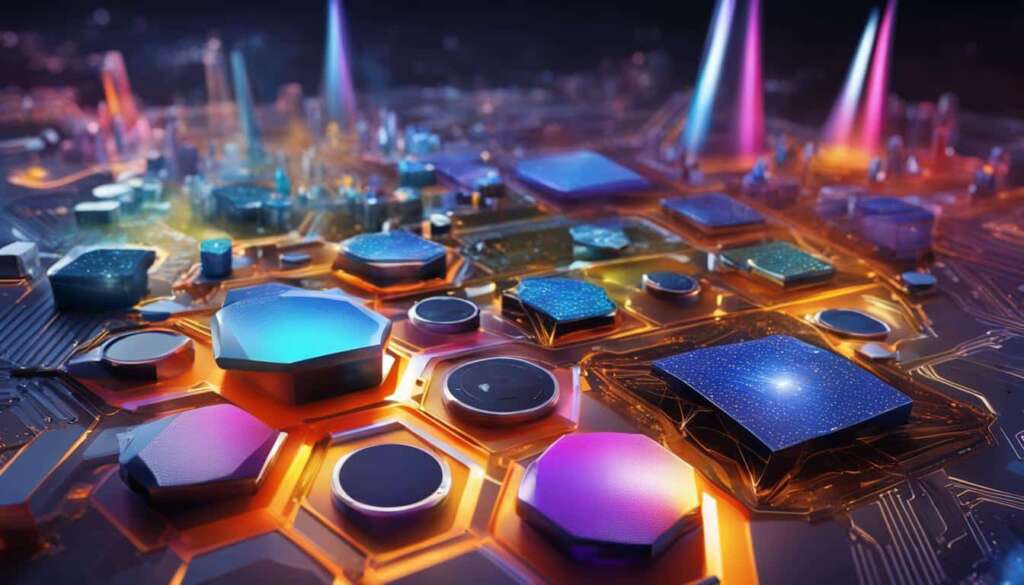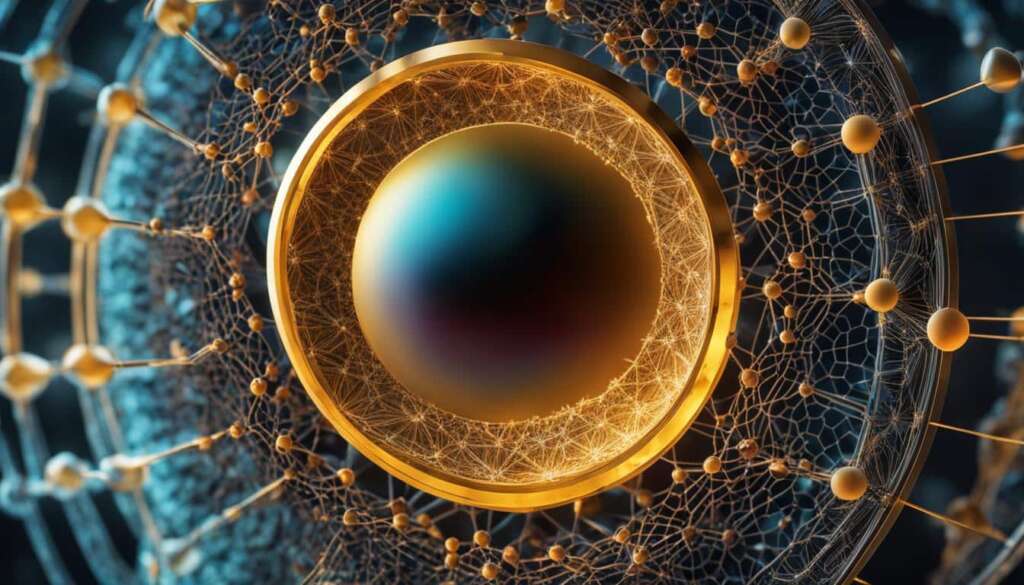Table of Contents
Nanotechnology, a cutting-edge field of modern science and technology, has captivated scientists and innovators around the world. Its existence and potential applications have been extensively researched, making it a prominent area of technological advancement.
At its core, nanotechnology involves manipulating matter at the atomic and molecular level. Through this approach, scientists have discovered that materials exhibit unique properties at the nanoscale. This understanding has paved the way for breakthroughs in medicine, electronics, energy, and many other industries.
From drug delivery systems in medicine to more efficient computer processors, nanotechnology has already had a significant impact on our lives. It enables the creation of super-strong materials, enhances diagnostic capabilities, and improves the efficiency of energy production. With its vast potential and diverse applications, nanotechnology promises a brighter future for science and technology.
Key Takeaways:
- Nanotechnology exists and has been extensively researched and applied in various industries.
- At the atomic and molecular level, materials exhibit unique properties that can be harnessed through nanotechnology.
- Everyday products, such as sunscreen and car paintwork, already utilize nanotechnology.
- In electronics, nanotechnology plays a crucial role in improving device performance and advancing computing capabilities.
- In medicine and healthcare, nanotechnology enables targeted drug delivery and innovative diagnostic techniques.
The Fundamentals of Nanotechnology
At its core, nanotechnology involves studying and manipulating matter at the atomic and molecular level. By understanding the behaviour of materials at this extremely small scale, scientists have discovered that such materials exhibit different properties than their larger counterparts. This understanding of materials at the nanoscale has led to the development of super-strong materials, enhanced drug delivery systems, and more efficient electronic devices.
Nanotechnology enables scientists to delve into the intricate world of atoms and molecules, unlocking new possibilities for innovation. By precisely engineering materials at the nanoscale, it becomes possible to modify their properties and create novel materials with exceptional characteristics.
One key aspect of nanotechnology is the unique behaviour of materials at the atomic and molecular level. At this scale, materials exhibit distinct thermal, optical, and magnetic properties. For example, a material that is typically brittle and fragile at the macroscopic level may become flexible and ductile at the nanoscale. This property transformation opens doors to advancements in various sectors, including aerospace, healthcare, and energy.
Nanotechnology’s impact on material properties can be seen in the development of super-strong materials. By manipulating materials at the atomic level, scientists can enhance their structural integrity and toughness. Carbon nanotubes, for instance, possess extraordinary strength, stiffness, and lightness, making them highly desirable for applications in aerospace, electronics, and other industries.
The precise control and manipulation of materials at the atomic and molecular level also enable enhanced drug delivery systems. Nanoparticles can be designed to encapsulate drugs and deliver them directly to targeted cells or tissues, increasing the efficiency of treatment while minimizing side effects. This targeted approach holds great promise for personalized medicine and improving patient outcomes.
Furthermore, nanotechnology plays a crucial role in the development of more efficient electronic devices. As electronic components continue to shrink, scientists rely on nanoscale fabrication techniques to create transistors, circuits, and sensors. The ability to manipulate materials at such small scales allows for the production of faster, smaller, and more energy-efficient electronic devices.
It is important to note that the properties and behaviour of nanoscale materials can differ significantly from those of their bulk counterparts. Understanding these differences is essential for harnessing the full potential of nanotechnology and driving further innovations.
Everyday Products Utilizing Nanotechnology
Nanotechnology is already present in many everyday products that we use. The integration of nanotechnology has revolutionized the functionality and performance of these products, enhancing their properties and making them more efficient.
An example of nanotechnology in everyday products is sunscreen. Sunscreens now contain nanoparticles of titanium dioxide and zinc oxide, which provide enhanced protection against harmful UV radiation. These nanoparticles form a protective barrier on the skin, reflecting and scattering the sun’s rays, preventing them from penetrating the skin’s surface.
In addition to sunscreens, nanotechnology has also made its way into clothing and furniture. By incorporating nanoparticles of silica into fabrics and materials, clothing and furniture can become waterproof and stain-proof. This hydrophobic and stain-resistant property ensures that spills and stains can be easily repelled, making these products more durable and long-lasting.
Nanotechnology has allowed for the creation of clothing and furniture that can repel liquids and stains, making them practical and easier to clean. This innovation has greatly improved the longevity and usability of these products.
Furthermore, nanotechnology plays a role in optimizing adhesives and coatings. Nanoparticles can be incorporated into adhesives, making them stronger and more reliable. This enables the creation of stronger bonds, enhancing the durability and effectiveness of everyday items.
When it comes to car paintwork, nanotechnology has brought about significant advancements in the development of coatings. Nanoparticle-based coatings are used to protect car surfaces from damage caused by UV radiation, scratches, and corrosion. These coatings provide a highly durable and protective layer, resulting in a longer-lasting and more vibrant appearance for vehicles.
The utilization of nanotechnology in everyday products has transformed the way we interact with and benefit from these items. By enhancing functionality and performance, nanotechnology has improved the quality and durability of sunscreens, clothing, furniture, adhesives, and car paintwork.
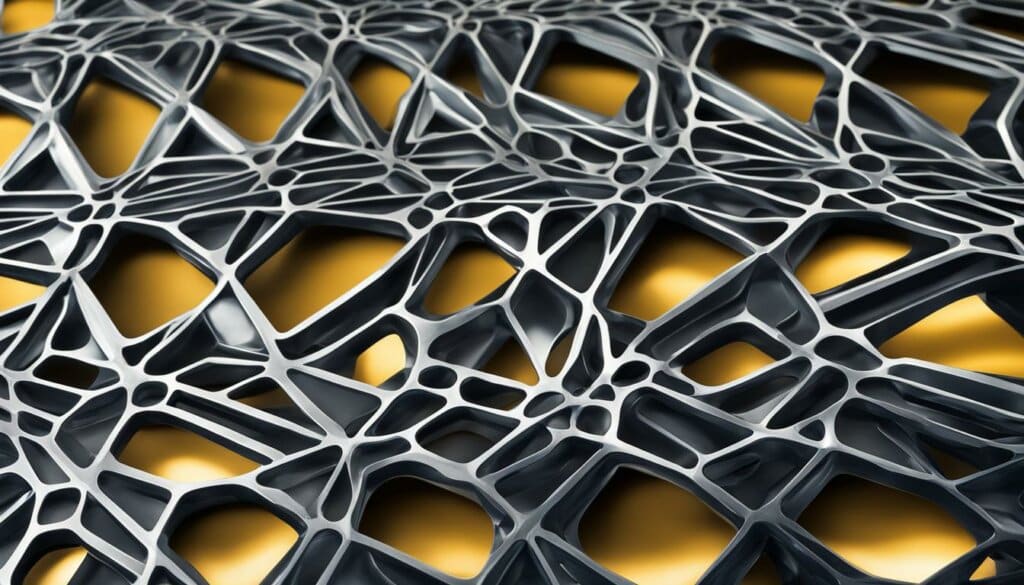
With nanotechnology continuing to evolve, we can expect further advancements in everyday products, leading to even more innovative and functional solutions for our daily lives.
Nanotechnology in Electronics and Computing
Nanotechnology plays a crucial role in the development of electronic devices and computing systems. Its impact on the field of electronics has been remarkable, enabling continuous advancements in computer processors, memory devices, and other electronic components. Through the manipulation of matter at the nanoscale, scientists have been able to create smaller, faster, and more efficient devices, revolutionizing the future of computing.
One of the key contributions of nanotechnology to electronics is the miniaturization of computer processors. As the size of transistors and circuitry decreases, the performance and efficiency of processors improve significantly. This enables the development of smaller and more powerful electronic devices, such as smartphones, tablets, and wearable technology. The ability to pack more transistors onto a single chip has also led to advancements in parallel computing, allowing for faster data processing and complex calculations.
Furthermore, nanotechnology has paved the way for the development of emerging technologies such as artificial intelligence (AI) and quantum computing. AI relies on powerful processors to run complex algorithms and analyze massive amounts of data. With nanotechnology, computing systems can handle the demanding computational requirements of AI applications, enabling advancements in machine learning, natural language processing, and computer vision.
Quantum computing, another frontier in computing, leverages the principles of quantum mechanics to perform calculations at an exponential speed. Nanoscale components, such as quantum bits or qubits, are essential to the development of quantum computers. These qubits can represent multiple states simultaneously, allowing for parallel processing and potential breakthroughs in solving complex problems that are currently intractable for classical computers.
Thanks to nanotechnology, computer processors are becoming smaller, faster, and more energy-efficient, opening up new possibilities for the future of computing. As we continue to explore the potential of nanoscale materials and devices, we are likely to witness even more transformative advancements, pushing the boundaries of what is currently achievable.
It is evident that nanotechnology has revolutionized the electronics industry and has become an indispensable component in the development of computing systems. The future of computing holds great promise, with nanotechnology at its core, driving innovations in AI, quantum computing, and other emerging technologies.
Advancements in Computer Processors through Nanotechnology
One of the most significant contributions of nanotechnology to the field of electronics is the continuous improvement of computer processors. Through the use of nanoscale materials and devices, processors have evolved to become smaller, more powerful, and energy-efficient. Here are some key advancements:
| Advancements | Description |
|---|---|
| Nanometer-scale Transistors | The size of transistors has decreased to nanometer-scale, allowing for a higher density of transistors on a single chip. This has led to increased processing power and efficiency. |
| Faster Clock Speeds | Nanotechnology has enabled processors to operate at faster clock speeds, resulting in quicker data processing and improved overall performance. |
| Reduced Energy Consumption | Nanoscale materials have lower power requirements, leading to more energy-efficient processors and longer battery life in portable devices. |
| Parallel Processing | With the miniaturization of transistors, processors can accommodate more cores, allowing for increased parallel processing and multitasking capabilities. |
These advancements in computer processors have had a significant impact on various industries, including telecommunications, healthcare, finance, and entertainment. The continuous progress in nanotechnology holds the promise of even smaller, faster, and more efficient processors in the future, fueling further innovation in computing and electronics.
Nanotechnology in Medicine and Healthcare
Nanotechnology has revolutionized the field of medicine and healthcare. Through the manipulation of matter at the atomic and molecular level, nanotechnology offers exciting possibilities for drug delivery, diagnostics, and regenerative medicine. By harnessing the unique properties of nanoparticles, scientists and healthcare professionals can develop innovative solutions to improve patient outcomes and advance medical treatments.
Enhanced Drug Delivery
One of the key applications of nanotechnology in medicine is the targeted delivery of drugs to specific cells or tissues. Nanoparticles can be engineered to encapsulate therapeutic agents, such as anticancer drugs, and transport them directly to the affected site in the body. This targeted approach enhances drug efficacy while minimizing side effects on healthy tissues.
Nanoparticles can overcome barriers, such as the blood-brain barrier, that limit the delivery of drugs to certain areas of the body. Additionally, the tunable surface properties of nanoparticles allow for controlled release of medications, ensuring a sustained therapeutic effect over time. This precise drug delivery system has the potential to revolutionize treatment strategies for a wide range of diseases, including cancer and neurological disorders.
Highly Sensitive Diagnostics
Nanosensors and nanodevices have proven to be valuable tools in diagnostic testing. These miniature devices can detect and analyze biomarkers, molecules, or even individual cells with remarkable sensitivity and specificity. By leveraging nanotechnology, diagnostic tests can provide rapid and accurate results, leading to early disease detection and personalized treatment approaches.
Nanotechnology also enables the development of point-of-care diagnostic devices, which can be used in resource-limited settings or remote areas where access to traditional laboratory facilities is limited. These portable devices offer convenience and speed, making them ideal for on-site testing and monitoring in healthcare settings.
Promising Regenerative Medicine
Regenerative medicine, the field focused on restoring or replacing damaged tissues and organs, has also benefited from nanotechnology advancements. Nanomaterials can be used as scaffolds to support tissue regeneration and guide the growth of new cells. This approach holds promise for the development of artificial organs and tissues, offering hope to patients awaiting transplants or seeking innovative alternatives.
Furthermore, nanotechnology enables the delivery of growth factors and other bioactive molecules to stimulate tissue regeneration. These nanoparticles can be designed to release the bioactive compounds in a controlled manner, promoting the growth of new blood vessels, bone tissue, or even nerve cells. This targeted approach accelerates the healing process and improves the success rates of regenerative therapies.
Overall, nanotechnology has ushered in a new era of possibilities in medicine and healthcare. By leveraging the unique properties and capabilities of nanoparticles, scientists and healthcare professionals are developing groundbreaking solutions for drug delivery, diagnostics, and regenerative medicine. As research in this field continues to evolve, nanotechnology holds great promise for revolutionizing healthcare and improving patient outcomes.
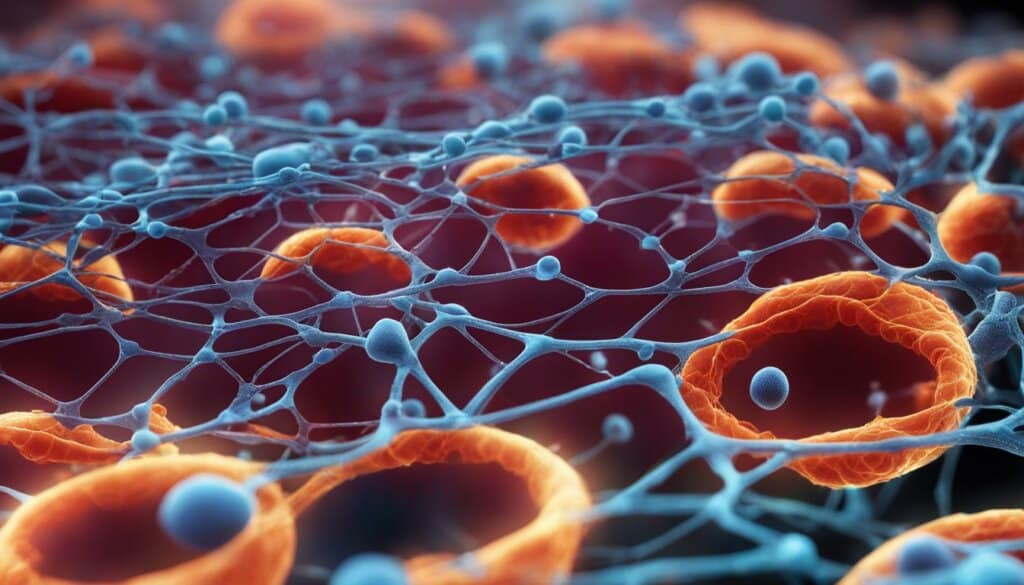
Nanotechnology in Energy and Environmental Applications
Nanotechnology offers a promising avenue for advancing clean energy production and environmental remediation. By harnessing the unique properties of nanomaterials, scientists are able to develop innovative solutions that improve the efficiency of energy sources and address environmental challenges.
One significant application of nanotechnology is in the realm of clean energy. Nanomaterials have the potential to enhance the performance of solar cells, batteries, and fuel cells, paving the way for more sustainable and efficient energy production. For example, nanoscale structures can increase the surface area of solar cells, allowing for better absorption of sunlight and higher conversion rates. Similarly, nanocomposites can enhance the capacity and charging speed of batteries, enabling longer-lasting and faster-charging energy storage.
Moreover, nanotechnology plays a crucial role in environmental remediation, aiding in the removal of pollutants from the air, water, and soil. Nanomaterials can be engineered to selectively adsorb or break down harmful substances, offering a more efficient and targeted approach to environmental cleanup. For instance, nanoparticles can be designed to capture and neutralize toxic chemicals in water, effectively purifying contaminated sources. Additionally, nanoscale catalysts can accelerate the degradation of pollutants, promoting the remediation of polluted soil and air.
| Nanomaterial | Application |
|---|---|
| Nanoparticles | Water purification |
| Nanoscale catalysts | Air and soil remediation |
| Nanofiltration membranes | Desalination and wastewater treatment |
In addition to these advancements, nanotechnology also offers the potential to improve the efficiency and sustainability of other energy sources such as wind and hydroelectric power. By utilizing nanomaterials in the design and maintenance of wind turbine blades and hydroelectric generators, researchers aim to optimize energy conversion and minimize resource wastage.
Overall, the integration of nanotechnology in energy and environmental applications holds tremendous promise for a greener and more sustainable future. Through continued research and innovation, nanomaterials have the potential to revolutionize energy production, reduce pollution, and mitigate environmental degradation.
Nanotechnology in Food and Agriculture
Nanotechnology holds great promise in addressing food safety concerns and improving agricultural practices. By utilizing nanoparticles, scientists can create innovative solutions to reduce the risk of contamination in the food industry and enhance productivity in agriculture. Let’s explore the potential applications of nanotechnology in food packaging, crop cultivation, and sustainable farming.
Antimicrobial Coatings for Food Safety
One of the key benefits of nanotechnology in the food industry is the development of antimicrobial coatings for food packaging and surfaces. Nanoparticles, such as silver and copper, possess natural antimicrobial properties. When incorporated into food packaging materials, these nanoparticles can inhibit the growth of bacteria, viruses, and fungi, effectively reducing the risk of foodborne illnesses.
Additionally, nanocoatings can be applied to food preparation surfaces, such as countertops and cutting boards, to create a protective barrier against microbial contamination. These nanomaterials can help maintain food safety standards and prolong the shelf life of perishable items by preventing the growth of spoilage-causing microorganisms.
Enhanced Crop Yields and Nutrient Delivery
In agriculture, nanotechnology offers the potential to improve crop yields and optimize nutrient delivery. Nanoparticles can be used as carriers for agricultural compounds, such as fertilizers and pesticides, allowing for precise and targeted application. This approach minimizes wastage and ensures that crops receive the necessary nutrients and pest protection, while reducing environmental impact.
Moreover, nanoscale delivery systems can enhance the bioavailability of nutrients to plants, increasing their uptake and utilization. This can lead to improved crop growth, resistance to diseases, and overall productivity. By leveraging the principles of nanotechnology, farmers can optimize resource utilization and contribute to sustainable agricultural practices.
Precision Farming and Sustainable Agriculture
Nanotechnology also enables the development of precision farming techniques that promote sustainable agriculture. By integrating nanosensors and nanodevices, farmers can monitor environmental factors, such as soil moisture, nutrient levels, and pest populations, with high accuracy and real-time data. This information allows for precise decision-making regarding irrigation, fertilization, and pest control, resulting in optimized resource allocation and reduced environmental impact.
Furthermore, nanotechnology can contribute to the development of innovative farming methods, such as vertical farming and hydroponics. These approaches maximize space utilization, minimize water and pesticide usage, and provide controlled environments for optimal plant growth. As a result, nanotechnology plays a crucial role in advancing the sustainability and efficiency of agricultural practices.
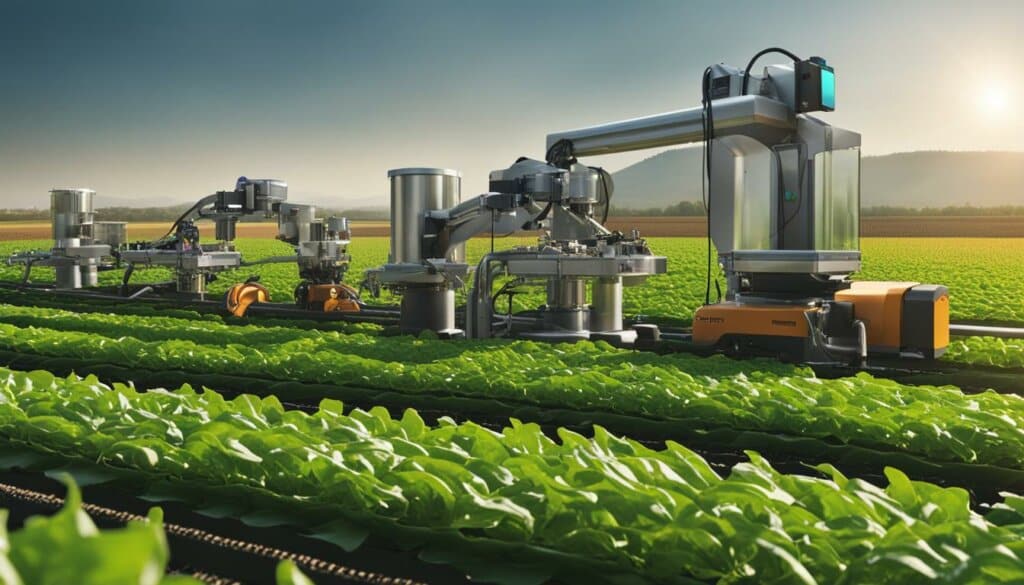
In summary, nanotechnology has the potential to revolutionize the food and agriculture industries by addressing food safety concerns, enhancing crop yields, and promoting sustainable farming practices. By leveraging the unique properties of nanomaterials, researchers and farmers can create innovative solutions that contribute to a safer, more efficient, and environmentally friendly food system.
Nanotechnology’s Impact on Society and Ethics
The widespread adoption of nanotechnology raises important ethical and societal considerations. As this cutting-edge field continues to advance, it becomes crucial to explore its impact on society, particularly in relation to ethics, privacy, and regulation.
Nanotechnology’s ability to manipulate matter at the atomic and molecular level raises ethical questions. For instance, there are concerns about the responsible development and use of nanotechnology in fields such as medicine, where questions of human enhancement and the potential for unintended consequences arise. To ensure ethical practices, collaborative efforts between scientists, policymakers, and ethicists are necessary.
Privacy Concerns:
The development of nanosensors and nanodevices raises privacy concerns. These powerful tools have the ability to collect and transmit vast amounts of personal data, leading to potential infringements of privacy rights. Balancing the benefits of technological advancements with the protection of individuals’ privacy requires clear guidelines and robust regulations.
Regulatory Challenges:
The rapid growth of nanotechnology highlights the need for effective regulation to ensure safety, transparency, and accountability. The unique properties and potential risks associated with nanomaterials require a comprehensive regulatory framework. Regulatory agencies must collaborate with scientists, industry experts, and policymakers to develop guidelines that address potential health and environmental impacts.
“The responsible development and use of nanotechnology require a proactive approach, with a focus on the potential risks and benefits, as well as transparent communication with the public.” – Dr. Emily Johnson, Ethicist
The development and application of nanotechnology should be guided by ethical principles, public engagement, and comprehensive regulation. Open dialogues involving scientists, policymakers, ethicists, and the public are necessary to navigate the complex ethical and societal implications of this transformative technology.
The Ethical and Societal Implications of Nanotechnology
| Impact | Ethical Considerations | Steps for Addressing |
|---|---|---|
| Human Enhancement | Potential for unequal access and concerns over modifying human nature | Collaborative efforts between scientists, ethicists, and policymakers to establish guidelines |
| Privacy | Collection and use of personal data through nanosensors and nanodevices | Clear guidelines and robust regulations to protect individuals’ privacy |
| Health and Safety | Potential risks of nanomaterials to human health and the environment | Comprehensive regulatory framework ensuring safety, transparency, and accountability |
| Social Disruption | Impact on employment, social structures, and cultural norms | Open dialogues involving all stakeholders to address concerns and guide responsible development |
Future Directions and Challenges in Nanotechnology
Nanotechnology is a field that holds great promise for the future. Ongoing research and innovation aim to unleash the full potential of nanotechnology and further expand its capabilities and applications. However, along with the exciting prospects, there are also significant challenges that need to be addressed in order to ensure the responsible development and widespread adoption of nanotechnology.
Future Advancements and Opportunities
The future of nanotechnology is poised for remarkable advancements. As scientists delve deeper into the nanoscale world, new possibilities emerge that could revolutionize various industries and sectors. From healthcare to energy, nanotechnology has the potential to drive innovation and shape the future. Ongoing research focuses on:
- Developing nanomaterials with enhanced properties and performance.
- Designing more efficient drug delivery systems for targeted therapy.
- Creating nanosensors for improved diagnostics and disease monitoring.
- Exploring nanoelectronics and quantum computing for unprecedented computing power.
These future developments in nanotechnology have the potential to transform our lives and open up new frontiers of exploration and discovery.
Challenges to Overcome
While the future of nanotechnology is promising, it is not without challenges. Addressing these challenges is crucial for the safe and responsible advancement of nanotechnology. Some key challenges include:
- Safety Concerns: The potential risks associated with nanomaterials need to be thoroughly understood and mitigated to ensure the well-being of both humans and the environment.
- Regulatory Frameworks: Developing effective regulatory frameworks that keep pace with the rapidly evolving field of nanotechnology is essential to ensure appropriate oversight and responsible use.
- Public Acceptance: Public awareness and understanding of nanotechnology are vital for its acceptance and successful integration into society. Educating the public about the benefits and potential risks of nanotechnology is crucial for fostering trust and acceptance.
By addressing these challenges, researchers, policymakers, and industry stakeholders can pave the way for a future where nanotechnology can flourish in a safe, ethical, and sustainable manner.
A Visual Snapshot of Future Directions and Challenges
To provide a visual overview of the future directions and challenges in nanotechnology, the following table summarizes the key areas of research and the corresponding challenges:
| Research Areas | Challenges |
|---|---|
| Advanced nanomaterials | Safety concerns and regulation |
| Drug delivery systems | Efficacy and targeted delivery |
| Nanosensors and diagnostics | Reliability and integration |
| Nanoelectronics and quantum computing | Scaling and commercialization |
This visual representation highlights the interconnected nature of future advancements and challenges in nanotechnology, emphasizing the need for holistic approaches and multidisciplinary collaboration.
In conclusion, the future of nanotechnology holds immense potential for scientific breakthroughs, technological advancements, and societal impact. Ongoing research and innovation drive the field forward, but challenges related to safety, regulation, and public acceptance must be carefully navigated. By addressing these challenges, we can pave the way for a future where nanotechnology meets its vast potential, contributing to a more sustainable and advanced world.
Conclusion
Nanotechnology, with its undeniable existence in the scientific community, has already made significant impacts across various industries. It has transformed the way we live and work, with applications in medicine, electronics, energy, and more. This field continues to evolve, presenting us with new opportunities and challenges.
As we navigate the world of nanotechnology, it is crucial to approach its potential benefits and challenges responsibly. While nanotechnology has the potential to revolutionize many aspects of our lives, it is essential to consider its impact on society and the environment. By adopting ethical practices and implementing proper regulations, we can ensure that nanotechnology continues to have a positive influence and contributes to the betterment of humanity.
With nanotechnology already making waves in medicine, electronics, and energy sectors, it is clear that this innovative field holds immense promise for the future. However, it is important to address challenges such as safety concerns, regulatory frameworks, and public acceptance to fully harness its potential. By conducting further research and fostering innovation in the field, we can continue to push the boundaries of what nanotechnology can achieve, driving progress and creating a better world.
FAQ
Does nanotechnology really exist?
Yes, nanotechnology is a rapidly evolving field that involves manipulating matter at the atomic and molecular level. It has been extensively researched and applied in various industries, including medicine, electronics, and materials science.
What is nanotechnology?
Nanotechnology involves studying and manipulating matter at the atomic and molecular level. Materials at this scale exhibit different properties than their larger counterparts, leading to the development of super-strong materials, enhanced drug delivery systems, and more efficient electronic devices.
How is nanotechnology used in everyday products?
Nanotechnology is already present in many everyday products. For example, sunscreens contain nanoparticles of titanium dioxide and zinc oxide, which provide enhanced protection against UV radiation. Nanoparticles of silica can be incorporated into clothing and furniture to make them waterproof and stain-proof. Nanotechnology is also used in adhesives and car paintwork to protect against damage.
How does nanotechnology impact electronics and computing?
Nanotechnology plays a crucial role in the development of electronic devices and computing systems. Advancements in nanotechnology have led to smaller and more powerful computer processors. Nanometer-scale transistors and circuitry enable the creation of smaller and more efficient devices.
What are the applications of nanotechnology in medicine and healthcare?
Nanoparticles can be engineered to deliver drugs directly to targeted cells, improving efficacy and reducing side effects. Nanosensors and nanodevices enable highly sensitive and rapid diagnostic testing. Nanotechnology also holds promise for regenerative medicine, with the ability to create artificial organs and tissues.
How does nanotechnology contribute to clean energy production and environmental remediation?
Nanomaterials can improve the performance of solar cells, batteries, and fuel cells, making renewable energy sources more viable. Nanotechnology is also used in environmental remediation, with nanomaterials being employed to remove pollutants from air, water, and soil.
What is the role of nanotechnology in food and agriculture?
Nanoparticles can be utilized to create antimicrobial coatings for food packaging and surfaces, reducing the risk of contamination. In agriculture, nanotechnology can improve crop yields, enhance nutrient delivery, and enable precision farming practices.
What are the ethical and societal considerations surrounding nanotechnology?
Issues such as privacy, equity, and the regulation of nanotechnology need to be carefully addressed. Questions regarding potential risks and benefits, as well as responsible development and use, require thorough examination and public dialogue.
What are the future directions and challenges in nanotechnology?
Ongoing research aims to further enhance the capabilities and applications of nanotechnology. However, challenges such as safety concerns, regulatory frameworks, and public acceptance need to be addressed to ensure the responsible development and widespread adoption of nanotechnology.
How does nanotechnology impact society?
Nanotechnology undeniably exists and has already made significant impacts across various industries. Its applications in medicine, electronics, energy, and other fields are transforming the way we live and work. As nanotechnology continues to evolve, it is important to responsibly navigate its potential benefits and challenges, ensuring its positive impact on society and the environment.

